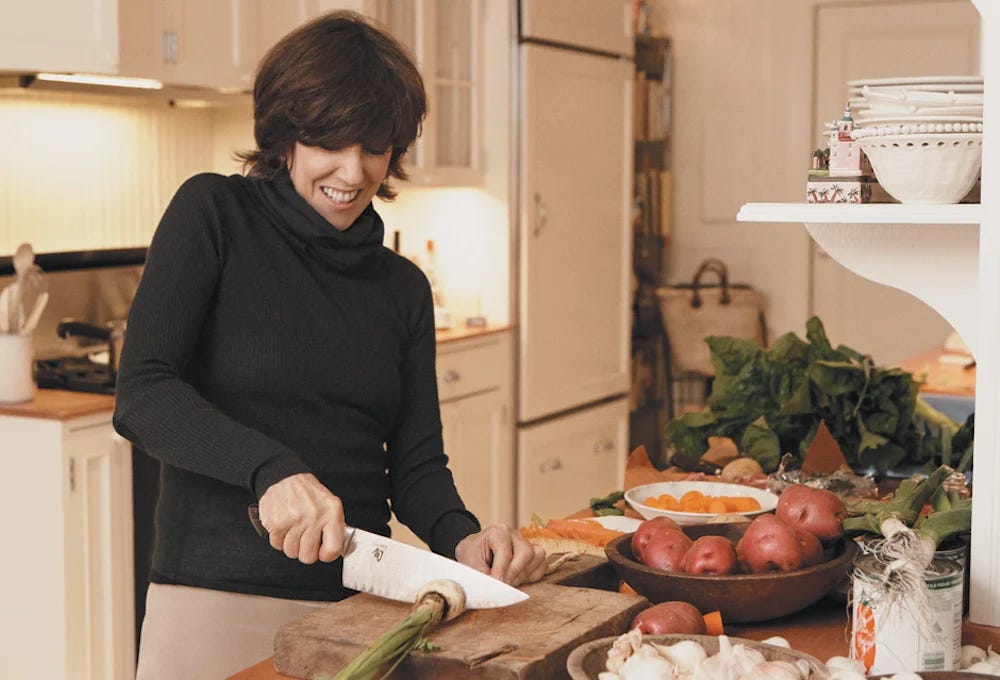How to throw a dinner party like Nora Ephron
Don’t host to dazzle. Host to belong—and to make others feel like they belong too.
The first time I hosted a dinner party, I was convinced that every single detail needed to be flawless—or else. Not just a minor hiccup, but a full-blown, catastrophic unraveling of my dignity. By “details,” I mean the arrangement of the silverware, the candlelight, the angle at which each plate was turned—every little touch painstakingly chosen to give off an effortless, curated charm.
This frenzy, mind you, was for a group of people who had eaten cold pizza on the floor and slept in the sleeping bags they carried around in their backpacks (a rather typical occurrence for a Czech student). These were the people. I had no romantic inclinations towards them, they weren’t even my friends to begin with.
Eventually, between bites of slightly undercooked chicken (it’s a true miracle no one has gotten salmonella), I had an overdue epiphany: a successful dinner party has little to do with the lighting or the silverware, and everything to do with actually having a good time (I am aware—genius) with good people. People remember how they felt. Not how the napkins were folded.
One of the few people who truly lived by this philosophy was the incomparable Nora Ephron. You can argue many things but you can’t argue the fact that Nora Ephron loved food and Nora Ephron loved a dinner party. She was a famously fabulous host. “I loved to cook, so I cooked. And then the cooking became a way of saying I love you. And then the cooking became the easy way of saying I love you. And then the cooking became the only way of saying I love you.”
Beyond her legacy as a sharp chronicler of modern womanhood, Nora knew how to throw a party. Her dinners were lively, opinionated, and delicious: four courses, round tables, no pretense.
For Ephron, food and storytelling were inseparable. Her novel (autobiography?) Heartburn revolves around a food writer’s unraveling marriage. It’s full of heartache and recipes for potatoes (Ephron LOVED potatoes). Julie & Julia pays homage to Julia Child and Julie Powell with reverent messiness — the film is delicious. Even that iconic scene in When Harry Met Sally, where Meg Ryan demonstrates the art of the fake orgasm (“I’ll have what she is having”), takes place over deli sandwiches. Food in Ephron’s world wasn’t background—it was a main character.
But her real gift was making it all feel easy. No stress, no fuss. Just make what you love, enjoy the night, and remember: no one cares about the table runner.
On setting the table and the tone
Nora Ephron believed that the shape of the table could shape the entire evening.
“It is absolutely essential to have a round table.”
Why? Because round tables create conversation. At a long, rectangular table, someone inevitably gets left out. A round table encourages flow—everyone is seen, everyone is heard. That said, if you must use a rectangular table (and Ephron often did), make sure it does its job: seat people thoughtfully and deliberately.
And whatever you do—don’t seat husbands next to wives. That’s a one-way ticket to boredom. Mix it up. Curate connections.
Ephron’s evolving attitude toward hosting was never about impressing people—it was about welcoming them.
“The point (I was starting to realize) was about putting it together. The point was making people feel at home, about finding your own style, whatever it was, and committing to it. The point was about giving up neurosis where food was concerned. The point was about finding a way that food fit into your life.”
You don’t need fine china or gourmet credentials. You just need a table, a warm room, and the willingness to feed people well. That’s it.
The Ephron formula for a perfect evening?
“You’ve got to get people hungry, sit them down informally, make them serve themselves, get them telling anecdotes, gossiping and staying late!”
In other words: embrace informality. Let people serve themselves. Encourage storytelling. Feed them until they’re full. And then keep them at the table just a little longer — that’s when the real conversations happen.
What to serve
First, what not to serve. Let’s get this straight: Do not serve hors d’oeuvres before dinner. The secret to a successful meal is hunger. Guests can’t help but love the food if they are starving. Nibbles before the main event ruin the drama.
And whatever you do—do not serve fish. Fish is boring. It’s delicate, fussy, and frankly, it doesn’t invite fun. You can’t play with fish. And you should be able to play with your food.
She emphasizes that most dinners consist of three components—a meat or fish, a starch, and a vegetable—but she advocates for a fourth element to elevate the meal. This could be something unexpected and delightful like applesauce, cornsticks, chutney, biscuits, tiny baked apples, or monkey bread (I have to admit I had to google what monkey bread was). Ephron attributes this insight to her friend, cookbook author Lee Bailey, whose dinner parties often featured simple dishes complemented by a surprising fourth item, such as baked crab apples.
The guiding principle of any dinner party should be: no one should go home hungry. Be generous. Be lavish. Use more butter than you think is reasonable.
“You can never have too much butter – that is my belief. If I have a religion, that's it.”
— Nora Ephron
And don’t be afraid of dietary cholesterol. As Ephron once declared (in all caps, no less):
“You can eat all sorts of things that are high in dietary cholesterol (like lobster and avocado and eggs) and they have NO EFFECT WHATSOEVER on your cholesterol count. NONE. WHATSOEVER. DID YOU HEAR ME?”
Dessert isn’t just a finale—it’s a ritual. And if you want guests to savor it, serve it with tiny spoons. Make it rich. Make it memorable. But most of all—make it last.
“Here’s the thing about dessert—you want it to last. You want to savor it. Dessert is so delicious. It’s so sweet. It’s so bad for you so much of the time. And, as with all bad things, you want it to last as long as possible. But you can’t make it last if they give you a great big spoon to eat it with.”
Sample Nora-Ephron-Inspired Menu:
Drink - Campari and blood orange
Starter - Arugula salad with shaved parmesan & lemon
Main - Roast chicken with butter, Dijon and crisp potatoes, sliced tomatoes with honey (a surprising element)
Dessert - Homemade chocolate cake with vanilla ice cream, olive oil and sea salt (served with the tiniest spoon you can find)
Guest list
Ephron's close ties to the film industry meant that her guest list often featured prominent actors and directors. Regular attendees included Tom Hanks, Rita Wilson, and Meg Ryan, all of whom had collaborated with her on iconic films like Sleepless in Seattle and You've Got Mail . Director Mike Nichols and actress Meryl Streep were also part of her inner circle. Ephron's parties were also frequented by Barbara Walters, Charlie Rose, and Gayle King.
The lesson here, I believe, is invite fun and exciting people with whom you have something to talk about and something to learn from.
THE INSIDE SCOOP from NYMAG: A weekend at Nick and Nora's definitely does not include a table at Nick & Toni's. In fact, their high-profile celebrity boarders hardly ever leave the low-profile East Hampton farmhouse. There are -- gasp! -- no servants, and the hosts prepare home-cooked meals from Nora's famous recipe notebook.
What to wear
Ephron was known for her affinity for turtlenecks and scarves, often using them as accessories. This preference was so notable that she was featured on Vanity Fair’s Best Dressed List in 2010, with special mention of her Chanel turtleneck. She liked tailored blazers, crisp button-down shirts, and wide-leg trousers, blending masculine and feminine elements for a polished look. She favored a palette of blacks, grays, and earthy hues.
In a memory piece, her son Jacob described her wearing “Chanel flats and cream-colored pants and a black-and-white-striped blouse.”
Don’t host to dazzle. Host to belong—and to make others feel like they belong too.




